
| KIT: | Trumpeter 1/32 F-5B Lightning (conversion) |
| KIT #: | ? |
| PRICE: | $129.95 MSRP |
| DECALS: | See Review |
| REVIEWER: | Tom Cleaver |
| NOTES: | Rutman conversion, cockpit and wheels used |

| HISTORY |
The Photo Lightning in the ETO:
The ability of airplanes to overfly the enemy's position was obvious, and the original military mission developed for aircraft was reconnaissance. On August 21, 1914, a British pilot flying over the Franco‑Belgian border spotted German Army units in position to cut off and surround the British Expeditionary Force.
This timely information allowed the British Army to retreat in good order to Mons, where there were defensible positions from which the British were able to contain the German advance following the First Battle of the Marne. Without this knowledge, the potential loss of the entire B.E.F. to capture and surrender in the first weeks of the war could have profoundly changed world history.
From 1914 until the Second World War, reconnaissance was deemed to be "battlefield observation," and the aircraft developed for the role differed only in basic technological development ‑ not in role change ‑ from the observation aircraft of the First World War. The U.S. Army Air Forces only began to take a serious look at long range photo reconnaissance in late 1940, after the Royal Air Force had demonstrated its value. The only USAAF aircraft to be specifically developed for photo reconnaissance and see operational service during the war was the P‑38 Lightning; in its photo‑recon role, the Lightning would receive the designation of F‑4A for the P‑38E and F conversions, F‑5A for those created from the P‑38G and H, F‑5B and F‑5E for the conversion of the P‑38J, and F‑5G for the development of the P‑38L. While the photo Lightnings were not that well‑known during the war, it is because there was aphoto‑Lighting that the type would survive after the war long enough to become a valued warbird, since the F‑5G was a mainstay of photogrammetric operations throughout the world until the early 1970s. All of today's surviving P‑38 warbirds except the Planes of Fame P-38J and 'Glacier Girl' were originally F‑5s.
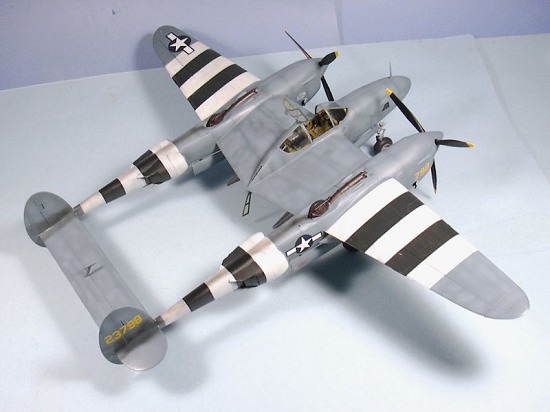 The Lightning, with its high speed and high altitude performance was seen
as a perfect airframe for photo‑ reconnaissance development, inasmuch as
cameras could be substituted for the nose armament. Operationally, the
airplane was expected to fly into enemy territory alone, depending on its
high performance to outrun enemy interceptors. Thus the slogan of the
photo‑recon pilots was born: "Alone, Unarmed, and Unafraid."
The Lightning, with its high speed and high altitude performance was seen
as a perfect airframe for photo‑ reconnaissance development, inasmuch as
cameras could be substituted for the nose armament. Operationally, the
airplane was expected to fly into enemy territory alone, depending on its
high performance to outrun enemy interceptors. Thus the slogan of the
photo‑recon pilots was born: "Alone, Unarmed, and Unafraid."
In the 8th Air Force, photo reconnaissance was seen as critical for bomb damage assessment following a bombing mission. Equally, there was a need for photo reconnaissance to develop information regarding German positions in the occupied countries for the coming invasion. The 67th Observation Squadron and the 3rd Photo‑Recon Group had been part of the initial strength of the organization when it was formed in the summer of 1942; the F‑4 Photo Lightnings of the 5th Photo Squadron arrived in June, as the first overseas deployment of the photo‑Lighting. However, by that fall only the 67th Observation Squadron remained with the 8th as the 3rd Photo Group and its Lightnings were sent on to the Twelfth Air Force to participate in the North African invasion.
It would not be until February 1943 that the 13th Photo Squadron, equipped with F‑4s and F‑5As, moved into Mount Farm airfield in Oxfordshire. Mount Farm was a satellite field of Benson, which was the base of the RAF's Photo Reconnaissance Unit. The original commander of the 13th Photo Squadron was a45‑year old First World War "retread," Major James G. Hall.
The photo‑Lightning operating out of England suffered all of the problems faced by its fighter brethren. High altitude missions were generally limited to a maximum of 25,000 feet, since the Lightning experienced engine trouble above this altitude. Even flying at 400 mph, operating at this altitude instead of the expected 35,000 feet meant that the photo‑ Lightnings could be vulnerable to interception by the Luftwaffe. The Germans were well aware of the purpose of a single aircraft operating at high altitude over Europe. German radar could easily track the intruders, and if the intercepting Bf‑109s or Fw‑190s were placed in position and given a sufficient altitude advantage, they could overhaul the Lightning in a dive more easily than they could the British Mosquito. The only real defense the photo ship had was to fly an erratic course to avoid interception by not allowing the German controller to position the fighters successfully. Additionally, the erratic flight course would hopefully conceal the target objective.
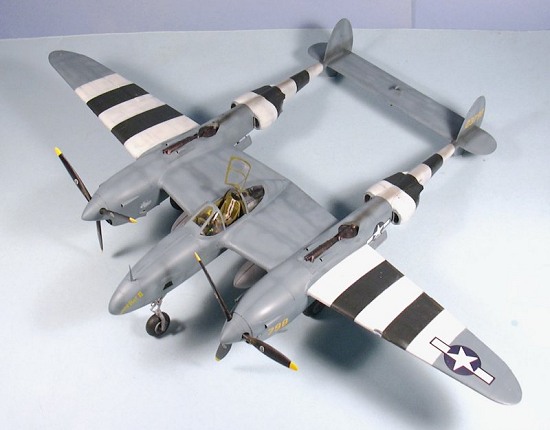 Major Hall flew the first operational photo‑Lightning mission over Europe
on March 28, 1943. From then on, the pilots of the 13th Photo Squadron
were engaged in photo‑reconnaissance and photo‑mapping of the Cherbourg
Peninsula and northern France.
Major Hall flew the first operational photo‑Lightning mission over Europe
on March 28, 1943. From then on, the pilots of the 13th Photo Squadron
were engaged in photo‑reconnaissance and photo‑mapping of the Cherbourg
Peninsula and northern France.
This area was the home stomping ground for JG 2 and JG 26, two of the premier fighter groups of the Luftwaffe, and the 13th experienced their first losses when two Lightnings failed to return in April, followed by another in May and four in June. As far as could be known, the losses were the result of the Lightnings losing an engine ‑ a very common experience in the P‑38 at this time in Europe ‑ which brought them down from high altitude and cut their speed to the point they were easy prey for the experten of these two Jagdgeschwadern. With seven losses and no replacements, the unit was hard‑pressed to maintain operations.
The 7th Photo Group was established in July 1943 at Mount Farm, with Hall promoted to Lt. Col. and placed in command of a unit that would eventually include two F-5 squadrons and a Spitfire squadron. That August, with sufficient experience, the 7th P.G. began to photograph targets hit by the heavy bombers. Among the first BDA missions were flights to Schweinfurt and Regensburg on August 17; as a result of the mission to Schweinfurt, it was determined that a second strike was necessary - this would finally be flown on October 14 and come to be known as "Black Thursday," the day the Luftwaffe stopped unescorted daylight bombing in its tracks.
Though the 7th experienced no operational losses for the rest of 1943, there was still much mechanical trouble with the Lightning. On August 19, 1943, a pilot was lucky to bail out over the English coast when his airplane broke up in flight. Sometimes the results of a mission were unexpected. In September, the new C.O. of the 13th Photo Squadron, Major James Wright, left his cameras on to use up unexposed film after photographing a target in Huls; he returned to Mount Farm having discovered a new synthetic rubber plant that was later bombed.
Since operations began the previous April, the 7th P.G. had been able to average 50 sorties a month with the photo‑Lightning. Despite the winter weather, the unit achieved 111 sorties in January as the 8th Air Force achieved its initial buildup and began large‑scale raids over Germany. In February ‑ the month of "Big Week" ‑ the Lightnings were over Germany on 161 missions, over three times the number of less than a year previously. This was due to the addition of a second Lightning unit, the 27th Photo Squadron, and the fact that the "bugs" were finally being ironed out of the F‑5.
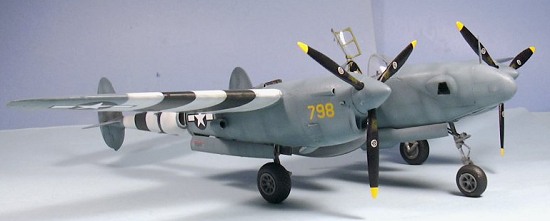 Because of the continued unreliability of the Allison engines at high
altitude over Europe, the Lightning was replaced at this time by
reverse‑Lend‑Lease Spitfire P.R.XIs for the dangerous BDA missions. The
Lightnings were returned to the job of photographic mapping of northwest
Europe for the coming invasion. To mask the real invasion area from the
Germans, the aircraft flew missions from Blankenberge to Dunkirk, and from
Le Touquet to St. Vaast de la Hague ‑ virtually the entire Channel Coast ‑
and with three missions flown elsewhere for every one flown over Normandy
and the Cherbourg Peninsula.
Because of the continued unreliability of the Allison engines at high
altitude over Europe, the Lightning was replaced at this time by
reverse‑Lend‑Lease Spitfire P.R.XIs for the dangerous BDA missions. The
Lightnings were returned to the job of photographic mapping of northwest
Europe for the coming invasion. To mask the real invasion area from the
Germans, the aircraft flew missions from Blankenberge to Dunkirk, and from
Le Touquet to St. Vaast de la Hague ‑ virtually the entire Channel Coast ‑
and with three missions flown elsewhere for every one flown over Normandy
and the Cherbourg Peninsula.
While the pilots had been trained for high‑altitude work, to meet the photographic needs immediately prior to d‑Day, they had to fly missions at extremely low altitudes. Starting on May 31st, the Lightnings flew along the French coast at wavetop height to get last‑minute detailed photos of obstacles and defenses on the invasion beaches.
The Loire River Death Ride of “Chili” Childress:
One of the most hair‑raising missions ever flown by the 7th Photo Group occurred when Major Hubert "Chili" Childress, Commanding Officer of the 27th Photo Squadron ‑ the last unit to arrive at Mount Farm in January 1944 ‑ was handed orders for a mission completely unlike anything he had flown in his six months of operations in the E.T.O.
"SHAEF wanted pictures of all the Loire River bridges, so they knew how they were made, because they wanted to blow them up to keep the German forces south of the Loire from crossing into northern France after the invasion. That meant going in at low level. We decided that we should fly the mission at a maximum altitude of 50 feet to stay below the treeline in our approaches to the bridges. In fact, I flew most of the mission at an altitude of 30 to 40 feet." Knowing the importance and danger of the mission, Childress assigned himself the flight.
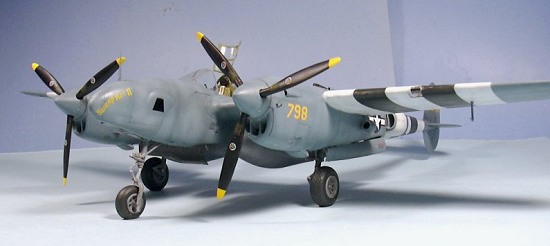 Because of the fact the F‑5 did not have a forward‑facing camera, Childress
would be forced to make his photo runs parallel to the bridges, crossing
back and forth across the river. “I had to fly straight and level, at a
maximum speed of 320 mph, a minimum of 200 yards from the bridge to get the
pictures.” Such a mission parameter put the F-5 at the optimum distance
for defending flak. A second P‑38 from the 13th Squadron was detailed to
follow Childress. "He was there to take over after I got shot down,"
Childress recalled. “I figured I might make it for four bridges before that
happened.” Since the Germans would be surprised at the first bridge but
fully warned and prepared as the mission went on, it was deemed so
dangerous that - like Childress - the 13th Photo Squadron's C.O. assigned
himself to the mission, being unwilling to risk the lives of any other of
his pilots.
Because of the fact the F‑5 did not have a forward‑facing camera, Childress
would be forced to make his photo runs parallel to the bridges, crossing
back and forth across the river. “I had to fly straight and level, at a
maximum speed of 320 mph, a minimum of 200 yards from the bridge to get the
pictures.” Such a mission parameter put the F-5 at the optimum distance
for defending flak. A second P‑38 from the 13th Squadron was detailed to
follow Childress. "He was there to take over after I got shot down,"
Childress recalled. “I figured I might make it for four bridges before that
happened.” Since the Germans would be surprised at the first bridge but
fully warned and prepared as the mission went on, it was deemed so
dangerous that - like Childress - the 13th Photo Squadron's C.O. assigned
himself to the mission, being unwilling to risk the lives of any other of
his pilots.
The mission was also different in that it would be the first flown by the 7th Photo Group to receive fighter escort. "We had 16 P‑38s from the 55th Fighter Group that met us over Cherbourg," Childress explained. "Four flew with me to provide flak suppression, four were with the other F‑5, and the other 8 were there to keep any German fighters that showed up off our backs."
There were a total of 64 bridges across the Loire that had to be photographed. By staying low, the Lightnings would only exposed to enemy flak during the few seconds they were directly over the bridges. By varying the direction they approached from, they were able to maintain the element of surprise as they took shots of the first 50 bridges.
"We took hits, but nothing serious, though every time I went past a bridge and saw all that flak coming up I figured I was taking a year off my life. When we got to Tours, there were four bridges inside the town, and we could only circle and head back and forth between them while staying directly over the city, which meant they could shoot at us continuously. The second and third bridges were so close together that when I was photographing one, I was directly over the other. That was where I got hit, over the third bridge. I felt a thump, but everything seemed to continue working, so I got pictures of the last bridge and then we were out of there. As I was flying along the river to the next target, the escort leader called on the radio and told me I was trailing smoke from the left engine. I looked out and sure enough, the cowling had a few holes in it and smoke was pouring out of the turbo. I feathered the prop and called to Major Smith that he'd have to get the rest of the bridges. I started climbing for altitude to get above the light flak, and managed to get it up to 10,000 feet by the time we got to the Channel."
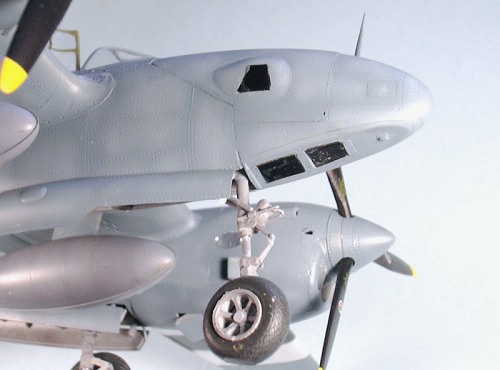 Once back at Mount Farm, Childress performed the standard entry maneuver
for landing, an overhead‑360 to the left, into the dead engine. "I'd
always been told never to turn a Lightning into the dead engine, but the
airplane was running so well no one on the ground even realized I was only
on one engine. I landed, but then I couldn't turn left off the runway, so
they had to come out and tow me back in. The airplane had enough holes in
it that it didn't fly again for about ten days."
Once back at Mount Farm, Childress performed the standard entry maneuver
for landing, an overhead‑360 to the left, into the dead engine. "I'd
always been told never to turn a Lightning into the dead engine, but the
airplane was running so well no one on the ground even realized I was only
on one engine. I landed, but then I couldn't turn left off the runway, so
they had to come out and tow me back in. The airplane had enough holes in
it that it didn't fly again for about ten days."
Three weeks later, on June 22, 1944, Childress had another close call. "I was to fly out to Poltava, in the Ukraine, to do bomb damage assessment for the unit that flew the first shuttle raid from England to Russia. It was a mission where I had to maximize my range to get all the way across Europe. My route was just south of the Baltic, to get photos of the airfields in northern Poland and the Baltic states which we had never been able to photograph before due to the distance, as well as bomb damage assessment photos of the synthetic oil plant in Ruhland they'd bombed. I decided to fly till each drop tank went dry and the engines stopped, so that I would use up all my fuel. I ran the first one dry over Schleswig Holstein, and dropped it. Then near the Polish border, I ran the left tank dry, and hit the jettison switch. Nothing happened! I worked it again and still nothing happened. I tried a third time and accompanied that with a nose‑up pitch, to put some Gs on the tank and pull it off. It came loose and the next thing I knew it somersaulted over the wing and hit the leading edge of the horizontal stabilizer, putting quite a dent in it! The airplane kept flying, and I’d gone too far to turn back, so I kept on with the mission and got the photos, then flew on to Poltava."
Childress arrived at Poltava the day after the German raid that destroyed 43 of the B‑17s that had been on the shuttle mission. "I spent an extra day there while they took sheet aluminum from the burned‑out B‑17s and made a patch for my tail. After it was fixed I took off and flew over Czechoslovakia and southern Germany, bringing back the photos of those eastern front airfields I'd gotten on the way over to Russia."
| THE KIT |
For a look at what's in the box and a brief history, please visit the preview.
| CONSTRUCTION |
For instruction in how to build the Trumpeter P-38 out of the box, please visit this review.
I will limit my comments on construction of the kit to those items necessary to modify the P-38L-5 airframe to a P-38J and how to use the Rutman F-5 nose conversion and resin cockpit.
The main modification that needs to be made to the airframe is to get rid
of the four fairings for the power-assisted controls of the P-38L, and to
get rid of the dive flaps.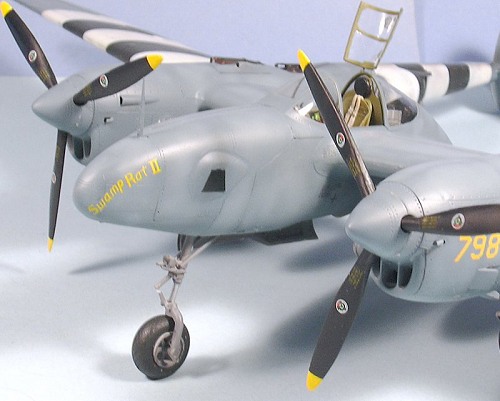
I filled each of the four fairings with cyanoacrylate glue, and when that was fully cured I cut them off with a razor saw. I then sanded the exterior surface smooth, applied Mr. Surfacer 500 to get a smooth finish, then rescribed the engraved rivets in that area with the tip of a#11 X-acto blade.
I cut a piece of Evergreen strip to fill in the cut out in the lower outer wing, and then sanded off the piano hinge line for the dive flaps. After applying Mr. Surfacer 500 and getting a smooth surface, I rescribed the engraved rivets in that area as I had for the fairings.
I then proceeded to assemble the airframe. I attach the movable control surfaces unassembled to their unassembled wing and fuselage parts, so that they can be glued from inside for a strong joint that will still keep the “break” on the exterior surface. I also only use the outer parts of the flaps, which allows the trailing edges to be glued tight when the wing is assembled. The Trumpeter kit has some fit problems, so you need to test-fit parts before gluing them in position. This is particularly true when assembling and attaching the radiator housings, and when attaching the booms to the wing. With careful attention paid to fitting these parts, you will only need a very little bit of Mr. Surfacer along the centerline seams to clean things up.
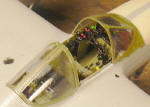 I
used the Rutman resin cockpit, which gives more fine detail than the kit
cockpit, and has a better, more accurate seat. I used the rear radio deck
from the kit, because it is easier to assemble and fit. The various
throttle levers and such were made with Evergreen strip, which I then
dipped in white glue to get the knob. When that had set, I dipped it in
cyanoacrylate glue to harden it. This is more complicated than using the
photo-etch levers, but they
I
used the Rutman resin cockpit, which gives more fine detail than the kit
cockpit, and has a better, more accurate seat. I used the rear radio deck
from the kit, because it is easier to assemble and fit. The various
throttle levers and such were made with Evergreen strip, which I then
dipped in white glue to get the knob. When that had set, I dipped it in
cyanoacrylate glue to harden it. This is more complicated than using the
photo-etch levers, but they
 look much more accurate to my eye, having had
the opportunity to sit in the cockpit of the Planes of Fame P-38 and look
things over closely. I used Cutting Edge posable resin seatbelts. The kit
instrument panel and control yoke was used, and the windshield and rear
canopy were Futured before they were painted from inside and then attached.
look much more accurate to my eye, having had
the opportunity to sit in the cockpit of the Planes of Fame P-38 and look
things over closely. I used Cutting Edge posable resin seatbelts. The kit
instrument panel and control yoke was used, and the windshield and rear
canopy were Futured before they were painted from inside and then attached.
The photo nose was assembled as a sub-assembly and carefully fitted and glued from inside, to minimize loss of surface detail when it came to fitting it. I then carefully test fitted it to the central fuselage nacelle, and built up the edges of the plastic kit to fit as closely to the resin parts as possible. The nose was filled with fishing weights and tested until there was enough in there to insure a nose-sit.
The resin prop blades were cleaned up and attached to the kit hub.
| COLORS & MARKINGS |
Painting:
After pre-shading the model, I applied the D-Day stripes and then masked them off. I used Xtracrylix RAF PRU Blue for the overall color, lightened with light grey and then with a very little bit of red to give high-altitude UV sun-fading to the finish. The wheel wells, gear door interiors and gear legs were painted Neutral Grey, since all P-38Js were finished this way.
Decals:
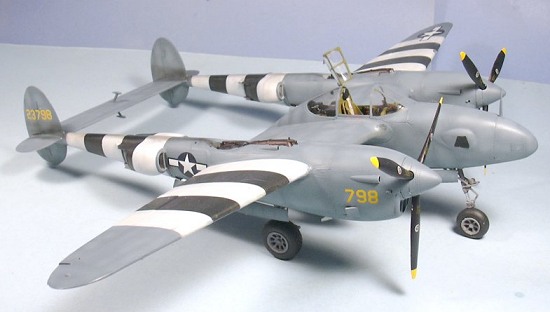 I
had originally wanted to do “Chili” Childress’ airplane as it appeared on
the Loire Bridges mission flown on May 31, 1944. However, that would mean
doing a very big model in one color. No matter how much pre-shading or
post-shading one does, it still ends up a big monochromatic mass. I
therefore decided to do the F-5B Childress flew for the June 22, 1944
mission across Europe to Poltava, since he assured me that at the time it
still had the full D-Day stripes prominently displayed, which he felt would
be useful when flying into the Soviet Union, since he was unsure of
Soviet aircraft recognition capabilities. While “Chili” still had the
information regarding serial number for the Loire Bridges airplane, he had
lost the logbook page for the Poltava mission and could only tell me it had
a name on the nose that he had forgotten. I found some photos of 27th
Photo Squadron F-5Bs and did the serial number for one, using numbers from
a sheet for B-17s in the decal dungeon, and a name from another sheet.
It’s not totally historically accurate, but it’s close and no one can say
specifically what it was, so when the model goes out to Planes of Fame to
memorialize the F-5 photo plane pilots, it’ll do just fine.
I
had originally wanted to do “Chili” Childress’ airplane as it appeared on
the Loire Bridges mission flown on May 31, 1944. However, that would mean
doing a very big model in one color. No matter how much pre-shading or
post-shading one does, it still ends up a big monochromatic mass. I
therefore decided to do the F-5B Childress flew for the June 22, 1944
mission across Europe to Poltava, since he assured me that at the time it
still had the full D-Day stripes prominently displayed, which he felt would
be useful when flying into the Soviet Union, since he was unsure of
Soviet aircraft recognition capabilities. While “Chili” still had the
information regarding serial number for the Loire Bridges airplane, he had
lost the logbook page for the Poltava mission and could only tell me it had
a name on the nose that he had forgotten. I found some photos of 27th
Photo Squadron F-5Bs and did the serial number for one, using numbers from
a sheet for B-17s in the decal dungeon, and a name from another sheet.
It’s not totally historically accurate, but it’s close and no one can say
specifically what it was, so when the model goes out to Planes of Fame to
memorialize the F-5 photo plane pilots, it’ll do just fine.
| FINAL CONSTRUCTION |
When all the decals were dry I gave the model a coat of Xtracrylix Satin Finish, then gave it two coats of thinned Dullcote to get a flat finish. I attached the Rutman resin wheels and the props, and then applied exhaust staining from the turbochargers with Tamiya
| CONCLUSIONS |
The Photo Lighting is the least-known of the P-38 sub-types, but the
missions flown by pilots - “alone, unarmed and unafraid” (though as “Chili”
told me, that last part was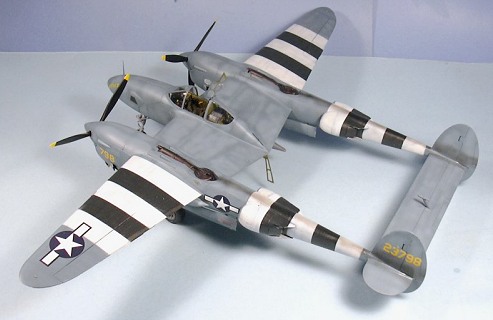 mostly bravado) - were among the most important
missions of the war. The work the 7th Photo Group Lightings did
over northwest Europe before the Normandy invasion were crucial to the
success of the greatest amphibious operation in history.
mostly bravado) - were among the most important
missions of the war. The work the 7th Photo Group Lightings did
over northwest Europe before the Normandy invasion were crucial to the
success of the greatest amphibious operation in history.
The Rutman conversion to create this model is easy to use, and results in a very distinctive-looking model.
And with this conversion, my career building Trumpeter P-38s comes to an end! I really think this is the best P-38 kit available. For anyone who likes Die Gabelschwantz Teufel, the kit is definitely worth the money. The Rutman conversion sets will allow you to build an early P-38 and an F-4A, a P-38M and the F-5B/E. Thank God these have all gone to Planes of Fame or I’d have had to build an addition to Le Chateau du Chat to house all these big models.
Review kit provided by Ed Maloney,"Rutman Conversion Parts courtesy of Jerry Rutman. Contact him at jrutman@ptd.net for prices and availability.
February 2005
| REFERENCES |
Sources: Interview with COL Hubert “Chili” Childress, USAF Ret’d, August 2002 for article published in Flight Journal “P-38 Special” issue, 2003.
If you would like your product reviewed fairly and quickly by a site that has 300,000 visitors a month, please contact me or see other details in the Note to Contributors.